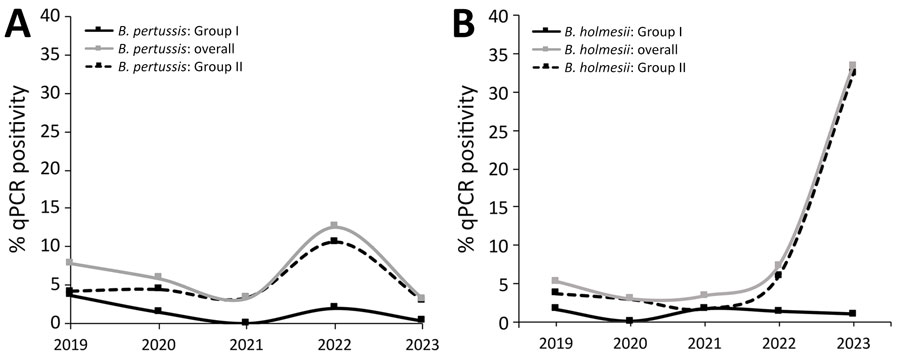Volume 31, Number 10—October 2025
Dispatch
Emergence of Bordetella holmesii–Associated Pertussis-Like Illness, Northern India, 2019–2023
Figure

Figure. Yearwise trend of Bordetella pertussis and B. holmesii positivity from study of emergence of B. holmesii–associated pertussis-like illness, northern India, 2019–2023. Data based on real-time quantitative PCR using the IS481-ptxS1-hIS1001 gene profile. Positiviity is shown overall and for 2 cohorts: group I (n = 213), patients hospitalized with acute respiratory illness at Postgraduate Institute of Medical Education and Research’s Advanced Pediatric Center; and group II (n = 722), obtained through the Vaccine-Preventable Disease Surveillance Network according to guidelines (9).
References
- Tan T, Dalby T, Forsyth K, Halperin SA, Heininger U, Hozbor D, et al. Pertussis across the globe: recent epidemiologic trends from 2000 to 2013. Pediatr Infect Dis J. 2015;34:e222–32. DOIPubMedGoogle Scholar
- Kilgore PE, Salim AM, Zervos MJ, Schmitt HJ. Pertussis: microbiology, disease, treatment, and prevention. Clin Microbiol Rev. 2016;29:449–86. DOIPubMedGoogle Scholar
- Vashishtha VM, Bansal CP, Gupta SG. Pertussis vaccines: position paper of Indian Academy of Pediatrics (IAP). Indian Pediatr. 2013;50:1001–9. DOIPubMedGoogle Scholar
- Elgarini M, Mennane Z, Sobh M, Hammoumi A. Bordetella holmesii: Causative agent of pertussis. Arch Pediatr. 2024;31:172–5. DOIPubMedGoogle Scholar
- Pittet LF, Emonet S, Schrenzel J, Siegrist CA, Posfay-Barbe KM. Bordetella holmesii: an under-recognised Bordetella species. Lancet Infect Dis. 2014;14:510–9. DOIPubMedGoogle Scholar
- Mir-Cros A, Codina G, Martín-Gómez MT, Fàbrega A, Martínez X, Jané M, et al. Emergence of Bordetella holmesii as a causative agent of whooping cough, Barcelona, Spain. Emerg Infect Dis. 2017;23:1856–9. DOIPubMedGoogle Scholar
- Rodgers L, Martin SW, Cohn A, Budd J, Marcon M, Terranella A, et al. Epidemiologic and laboratory features of a large outbreak of pertussis-like illnesses associated with cocirculating Bordetella holmesii and Bordetella pertussis—Ohio, 2010-2011. Clin Infect Dis. 2013;56:322–31. DOIPubMedGoogle Scholar
- Templeton KE, Scheltinga SA, van der Zee A, Diederen BM, van Kruijssen A, Goossens H, et al. Evaluation of real-time PCR for detection of and discrimination between Bordetella pertussis, Bordetella parapertussis, and Bordetella holmesii for clinical diagnosis. J Clin Microbiol. 2003;41:4121–6. DOIPubMedGoogle Scholar
- Ministry of Health & Family Welfare (India). Surveillance for diphtheria, pertussis and neonatal tetanus [updated 2020 Oct 14]. New Delhi: Ministry of Health & Family Welfare. [cited 2025 May 14]. https://drive.google.com/file/d/1mm96-ouH1A2ibefH8zBKWaUfpuD63G2h/view?usp=sharing
- Tatti KM, Sparks KN, Boney KO, Tondella ML. Novel multitarget real-time PCR assay for rapid detection of Bordetella species in clinical specimens. J Clin Microbiol. 2011;49:4059–66. DOIPubMedGoogle Scholar
- Kamiya H, Otsuka N, Ando Y, Odaira F, Yoshino S, Kawano K, et al. Transmission of Bordetella holmesii during pertussis outbreak, Japan. Emerg Infect Dis. 2012;18:1166–9. DOIPubMedGoogle Scholar
- Yih WK, Silva EA, Ida J, Harrington N, Lett SM, George H. Bordetella holmesii-like organisms isolated from Massachusetts patients with pertussis-like symptoms. Emerg Infect Dis. 1999;5:441–3. DOIPubMedGoogle Scholar
- Pittet LF, Emonet S, François P, Bonetti EJ, Schrenzel J, Hug M, et al. Diagnosis of whooping cough in Switzerland: differentiating Bordetella pertussis from Bordetella holmesii by polymerase chain reaction. PLoS One. 2014;9:
e88936 . DOIPubMedGoogle Scholar - Diavatopoulos DA, Cummings CA, van der Heide HG, van Gent M, Liew S, Relman DA, et al. Characterization of a highly conserved island in the otherwise divergent Bordetella holmesii and Bordetella pertussis genomes. J Bacteriol. 2006;188:8385–94. DOIPubMedGoogle Scholar
Page created: September 02, 2025
Page updated: September 25, 2025
Page reviewed: September 25, 2025
The conclusions, findings, and opinions expressed by authors contributing to this journal do not necessarily reflect the official position of the U.S. Department of Health and Human Services, the Public Health Service, the Centers for Disease Control and Prevention, or the authors' affiliated institutions. Use of trade names is for identification only and does not imply endorsement by any of the groups named above.